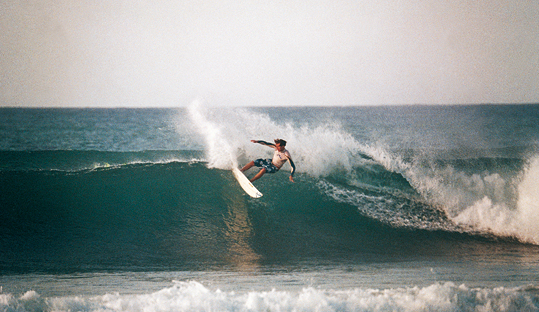Stormrider Guide to surfing Martinique
Martinique, CENTRAL AMERICA & CARIBBEAN
|
 Martinique surfing, Nicolas Labat
Martinique surfing, Nicolas Labat
|
Summary
|
+ Good righthand reef set-ups
|
- Seasonal north swells
|
|
+ Consistent Tartane spots
|
- Onshore trade winds
|
|
+ Low tidal influence
|
- Sharp shallow reefs
|
|
+ Safe tourist haven
|
- Some crowded spots
|
|
|
Martinique lies in the heart of the Lesser Antilles, or Windward Islands and is dominated by the peaks of the Carbet and the Mont PelŽe dormant volcanoes. The southern shores are highly regarded by tourists seeking picture perfect beaches, leaving surfers to focus on the northern and eastern coastline, ideally exposed to winterÕs North Atlantic swell and peppered with volcanic and coral reefs. The main waves are concentrated on the unusually protruding Caravelle Peninsula close to Tartane, allowing for offshore winds on an otherwise windblown east coast. The southern beaches can provide a summer swell bodyboard option.
When to Go
The main swell season is from November to March, with 3-10ft N-NE North Atlantic groundswells. Constant 2-5ft E windswells occur year-round, so surfing small sloppy waves is always an option around the Caravelle peninsula. The highly unpredictable hurricane season can bring some of the largest swell of the year between July and September. Dominant E trade winds vary from 44% (Nov) to 70% (Jul), blowing more NE than SE. Max 0.8m tides.
Surf Spots
Statistics |
J
|
F
|
M
|
A
|
M
|
J
|
J
|
A
|
S
|
O
|
N
|
D
|
| dominant swell |
N -E |
N -E |
NE -SE |
NE -SE |
N -E |
N -E |
| swell size (ft) |
4 |
3 |
1-2 |
2 |
3-4 |
4 |
| consistency (%) |
70 |
60 |
40 |
40 |
60 |
70 |
| dominant wind |
NE -E |
NE -E |
NE -SE |
NE -SE |
NE -SE |
NE -E |
| average force |
F4 |
F4 |
F4 |
F4 |
F4 |
F4 |
| consistency (%) |
80 |
77 |
85 |
97 |
89 |
76 |
| water temp (C) |
25 |
25 |
26 |
28 |
28 |
26 |
| wetsuit |
boardshorts |
boardshorts |
boardshorts |
boardshorts |
boardshorts |
boardshorts |
|
Travel Information
Weather
Jan to June are the cooler and drier months (carme), and the wet season runs from July to Dec (hivernage). The southern area of the island tends to be drier. Daytime temperatures can reach 30¡C (86¡F) and thereÕs only about a 5¡C (9¼F) difference between summer and winter temperatures. Two regular, alternating wind directions from NE and ESE.
|
Lodging and Food
Accommodation options range from large hotels to family-run ÒRelais CrŽoles,Ó or ÒG”tes de FranceÓ, usually studios in private homes. Around Tartane, try RŽsidence OcŽane (fr $90/n), LÕh™tel La Caravelle ($90/dble) or Bliss from $325/wk. Sample MartiniqueÕs culinary magic, a marriage of French and Creole cuisines.
|
Nature and Culture
Hiking, diving and mountain biking are great. A wealth of sightseeing: white sand beaches, tropical rainforest, floral gardens and the majestic Mount Pelee. Sample product at rum distilleries before dancing to Biguine and Zouk.
|
|
